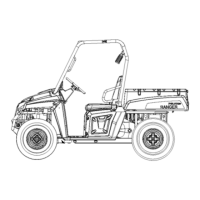2.14
MAINTENANCE
ENGINE
Compression and Leakdown Test
NOTE: This engine does NOT have decompression
components. Compression readings will vary in
proportion to cranking speed during the test.
Average compression (measured) is about 150-200
psi during a compression test.
A smooth idle generally indicates good compression. Low
engine compression is rarely a factor in running condition
problems above idle speed. Abnormally high compression can
be caused by carbon deposits in the combustion chamber or
worn, damaged exhaust cam lobes. Inspect camshaft and
combustion chamber if compression is abnormally high.
A cylinder leakdown test is the best indication of engine
condition. Follow manufacturer's instructions to perform a
cylinder leakage test (never use high pressure leakage testers, as
crankshaft seals may dislodge and leak).
Breather Hose Inspection
The engine is equipped with a breather hose (A). Inspect the
breather hose for possible kinks or wear. The hose is form fit-
ted for a proper fit. Follow the breather hose from the side of
the airbox to the engine valve cover.
NOTE: Make sure lines are not kinked or pinched.
Engine Oil Level
The twin cylinder engine is a wet-sump engine, meaning the oil
is contained in the bottom of the crankcase. To check the oil
level follow the procedure listed below.
1. Set machine on a level surface and set the parking brake.
2. Be sure the machine has sat for awhile before removing the
dipstick.
IMPORTANT: Do not run the machine and then check
the dipstick.
3. Stop engine and unlock the lever lock. Remove dipstick
and wipe dry with a clean cloth.
Cylinder Compression
Standard: 150-200 PSI
Cylinder Leakdown
Service Limit 15%
(Inspect for cause if test exceeds 15%)
Dipstick
Lever Lock
Dipstick

